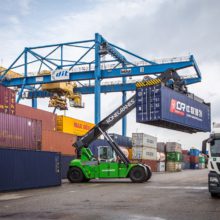
The heavy-load stacker claims a lifting capacity of 45 metric tons and claims to consume at least 30 percent less fuel than a comparable diesel-driven model in normal operation. “We decided in favour of this machine because it will help to bring us nearer to our sustainability goal of reducing our CO2 emissions by ten percent by 2020”, says Bernd Putens, Managing Director of Duisburg Intermodal Terminal. “We are expecting the machine to perform just as well as diesel-driven reach stackers. We expect substantial cost savings in the medium term due to longer maintenance intervals and fewer downtimes.”
Regenerative electric motors
In 2013, Konecranes developed the first hybrid reach stacker in the world. The SMV 4531 TB5 HLT now in operation at Contargo has a drive consisting of a diesel engine, an electrical generator and an electric motor for driving. The diesel engine has an engine power of 230 kW and runs at a maximum speed of 1,800 rpm in the optimal consumption range. The regenerative electric motors provide the power for the drive and the lift system. Braking energy and load lowering energy are fed back into the system and stored for later use, which cuts fuel consumption and substantially reduces the burden on the environment. The hydraulic pumps of the Hybrid Reach Stacker are electrically driven and electronically controlled. The speed of the pumps, which supply hydraulic energy for lifting and steering, can be controlled independently of the speed of the diesel engine. This enables a much faster response at maximum performance requirement, as well as a lower noise level when the Hybrid Reach Stacker is in driving mode.

